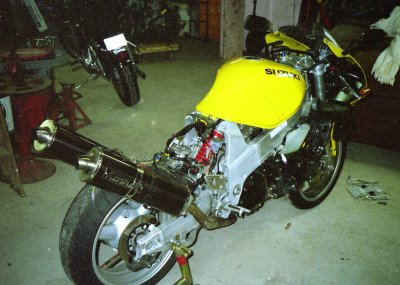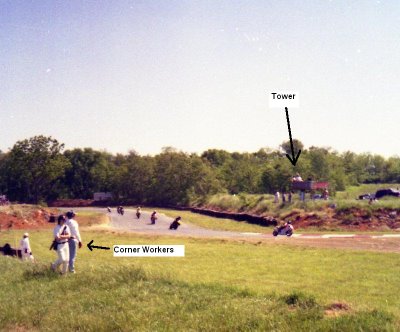Safety First (Memories Cont.)
The Thanksgiving following the October Pocono crash on the "track bike", I had another crash of sorts. On my way to TN (with the TLR - hooligan street bike - in the back of the truck) to visit my folks for the holiday, I stopped to see my Grandmother in Wv. While there that night, my appendix burst. Eventually my bike and I made it to TN, but for reasons I can't recall, the bike stayed there when I was finally able to come home.
It was either Christmas or shortly there after, that I went back down. Along the way in Virginia, I stopped at a gentleman's house to pick up a "control unit" used for reprogramming the EFI on TLRs. Once in TN, it didn't take my father and I long to start mucking with the beast.
 It worked. It was "seat of the pants" faster then before - not that it really needed to be, but what the hell.
It worked. It was "seat of the pants" faster then before - not that it really needed to be, but what the hell.
Back home I had other cycle issues to deal with. The track bike was still banged up from the fall. With a few months still before track season, I set about fixing it. I also set about a full proof plan to finally achieving my race license.
A lot of time and effort goes into motorcycle racing from all angles. One of the most important and often missed is corner working. Corner workers are vital to track safety. They are the eyes and ears to all the dangers and issues that might arise during an event. They are as they are described - workers at each corner.
 Using flags, they signal to riders track conditions, dangers and safety concerns. In the event of an accident or issue, they swiftly take care of it so racing may safely continue. In the mid-atlantic the main corner working organization is MARRC. They have a deal where you volunteer to corner work for a weekend, they give you a discount toward race school and earning your license. Essentially corner working is the ultimate race school. Standing in the middle of a track all day watching the action from a safety point of view teaches you real quick what's right and wrong as far as racing goes.
Using flags, they signal to riders track conditions, dangers and safety concerns. In the event of an accident or issue, they swiftly take care of it so racing may safely continue. In the mid-atlantic the main corner working organization is MARRC. They have a deal where you volunteer to corner work for a weekend, they give you a discount toward race school and earning your license. Essentially corner working is the ultimate race school. Standing in the middle of a track all day watching the action from a safety point of view teaches you real quick what's right and wrong as far as racing goes.
After a successful track day at Summit Point in mid to late March, I signed up for the corner working deal and paid my dues sometime in early April.
- b
It was either Christmas or shortly there after, that I went back down. Along the way in Virginia, I stopped at a gentleman's house to pick up a "control unit" used for reprogramming the EFI on TLRs. Once in TN, it didn't take my father and I long to start mucking with the beast.
 It worked. It was "seat of the pants" faster then before - not that it really needed to be, but what the hell.
It worked. It was "seat of the pants" faster then before - not that it really needed to be, but what the hell.Back home I had other cycle issues to deal with. The track bike was still banged up from the fall. With a few months still before track season, I set about fixing it. I also set about a full proof plan to finally achieving my race license.
A lot of time and effort goes into motorcycle racing from all angles. One of the most important and often missed is corner working. Corner workers are vital to track safety. They are the eyes and ears to all the dangers and issues that might arise during an event. They are as they are described - workers at each corner.
 Using flags, they signal to riders track conditions, dangers and safety concerns. In the event of an accident or issue, they swiftly take care of it so racing may safely continue. In the mid-atlantic the main corner working organization is MARRC. They have a deal where you volunteer to corner work for a weekend, they give you a discount toward race school and earning your license. Essentially corner working is the ultimate race school. Standing in the middle of a track all day watching the action from a safety point of view teaches you real quick what's right and wrong as far as racing goes.
Using flags, they signal to riders track conditions, dangers and safety concerns. In the event of an accident or issue, they swiftly take care of it so racing may safely continue. In the mid-atlantic the main corner working organization is MARRC. They have a deal where you volunteer to corner work for a weekend, they give you a discount toward race school and earning your license. Essentially corner working is the ultimate race school. Standing in the middle of a track all day watching the action from a safety point of view teaches you real quick what's right and wrong as far as racing goes.After a successful track day at Summit Point in mid to late March, I signed up for the corner working deal and paid my dues sometime in early April.
- b
0 Comments:
Post a Comment
<< Home